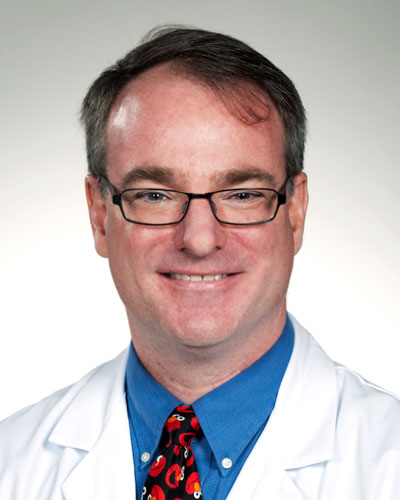Study Examines Blended Learning in Clinical Settings
April 11, 2017
Dr. Erik Langenau's study, published in the April issue of the Journal of the American
Osteopathic Association, examined the effectiveness of a blended-learning format for
third-year osteopathic medical students completing their pediatric clinical rotations.
With technological advances continuing to improve the field of healthcare, a pilot
study led by Erik Langenau, DO, MS, chief academic technology officer and associate professor, pediatrics, has found
that for future physicians, while online tools can be useful for learning, nothing
tops face-to-face interaction with a patient.
The study, published in the April issue of the Journal of the American Osteopathic Association, studied the effectiveness of a blended-learning format (online materials combined
with face-to-face instruction) for third-year osteopathic medical students completing
their pediatric clinical rotations.
Students who participated in the hybrid format—which included online materials such
as discussion boards, blogs, video demonstrations and virtual patient encounters—generally
performed as well as their counterparts in the traditional cohort, and in fact had
higher final scores than their traditional counterparts. But regardless of how helpful
the online materials were, the majority of students in the hybrid cohort reported
a desire to keep, and even increase, their level of patient interaction.
“Much of the current literature talks about replacing patient interaction with online
materials—particularly with videos, games, or virtual patient encounters,” said Dr.
Langenau. “But what was surprising was that our students said, ‘No, we want that face-to-face
connection.’ As osteopathic physicians, we value that human connection, and it was
very heartening to see our students reflect that desire to connect with patients.”
Dr. Langenau said the impetus to study the effectiveness of blended learning stemmed
from two areas. First, to improve educational consistency across clinical sites; he
noted that if one student rotates through a private practice, and another rotates
through a hospital setting, the two will receive very different experiences. Providing
a consistent online curriculum helps close that educational gap between rotation sites,
he said. The second was to help alleviate the burden on clinical preceptors, many
of whom may not have the time to provide thorough didactic instruction.
“I kept thinking back to my time on surgery rotation,” he said. “I spent a month in
cardiothoracic surgery, and I was never quite sure what I was supposed to be learning.
I would assist with a surgery but be unsure of what I should focus on. We believe
that by providing online materials, we can help our students understand learning objectives
for the course and better prepare for when they step into the clinical setting.”
To test the effectiveness of the blended learning model, Comprehensive Osteopathic
Medical Achievement Test (COMAT) scores were compared between the blended learning
cohort (78 students) and the traditional cohort (186 students), and found to be roughly
equal across both. In addition, COMAT scores were combined with preceptor evaluations
for a final score of “honors,” “high pass,” “pass” or “fail,” and more students the
hybrid cohort received a final score of “honors.” However, the researchers noted that
more study is needed to determine why that score was higher.
Among those in the blended learning cohort, roughly 70 percent completed a post-survey
to determine their level of satisfaction with that format. Half reported that they
preferred the hybrid format to the traditional, and more than 80 percent reported
being satisfied with the overall experience.
Dr. Langenau says that while this initial study is small, and only looked at one specific
rotation, its results are promising. PCOM has since expanded this model to psychology,
ob/gyn, cardiology, internal medicine and urban health rotations, and he plans to
study the effectiveness of blended learning across all core clinical clerkships.
The College has also hired additional faculty as online clinical preceptors, who are
responsible for supervising the online components of their respective courses as students
continue to work with their preceptors in the clinical setting. PCOM plans to expand
the program for all core rotations with plans to hire two more online clinical preceptors
in the coming academic year.
Other authors on this study were Robert Lee, DO, MS, clinical assistant professor,
pediatrics, and Marci Fults (DO ’18).
You May Also Like:
About Philadelphia College of Osteopathic Medicine
Established in 1899, Philadelphia College of Osteopathic Medicine (PCOM) has trained
thousands of highly competent, caring physicians, health practitioners and behavioral
scientists who practice a “whole person” approach to care—treating people, not just
symptoms. PCOM, a private, not-for-profit accredited institution of higher education,
operates three campuses (PCOM, PCOM Georgia and PCOM South Georgia) and offers doctoral degrees in clinical psychology, educational psychology, osteopathic
medicine, pharmacy, physical therapy, and school psychology. The college also offers
graduate degrees in applied behavior analysis, applied positive psychology, biomedical
sciences, forensic medicine, medical laboratory science, mental health counseling,
physician assistant studies, and school psychology. PCOM students learn the importance
of health promotion, research, education and service to the community. Through its
community-based Healthcare Centers, PCOM provides care to medically underserved populations.
For more information, visit pcom.edu or call 215-871-6100.
Contact Us
For general media inquiries, please contact the Office of Marketing and Communications
at 215-871-6300 or communications@pcom.edu. Visit our media relations page to view contact information for public relations personnel.
Connect with PCOM

